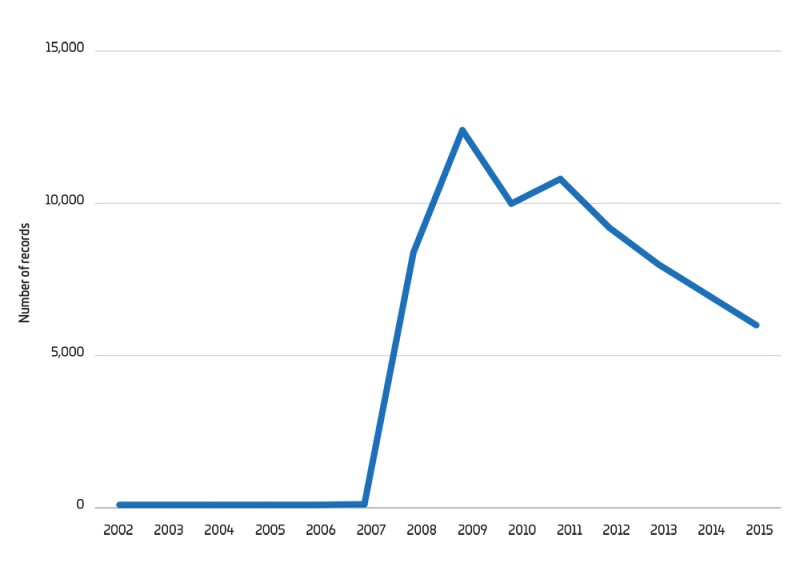Under Article 12 of the Chinese Patent Law "any entity or individual exploiting the patent of another shall conclude with the patentee a license contract for exploitation and pay the patentee a fee for the exploitation of the patent."
Rule 14, paragraph two of the Implementing Regulations for the Chinese Patent Law states that "any license contract for exploitation of a patent which has been concluded by the patentee with an entity or individual shall, within three months from the date of entry into force of the contract, be submitted to the patent administration department under the State Council for the record."
Recording of a license contract for exploitation of a patent refers to action by the patent office of the State Intellectual Property Office to retain the license contract for exploitation of a patent that the parties have concluded, when it takes effect and publicise to the public.
Recording of a license contract for exploitation of a patent is completed on 'patent announcements' and recorded in the patent register. Information on records of licensing for exploitation of Chinese patents is freely available on the China National Intellectual Property Administration (CNIPA) website under 'China patent announcement' (http://epub.cnipa.gov.cn/flzt.jsp).
For a recorded license contract for exploitation of a patent, the licensor, licensee, main classification number, patent number, application date, authorisation announcement date, type and period of exploitation license, and recording date are announced in the Patent Gazette.
'Measures for the record filing of patent licensing contracts' (implemented in 2011) published by the State Intellectual Property Office sets out detailed regulations on recording procedures and requirements.
Why file a license contract for patent exploitation for the record?
In China, the absence of filing a license contract for patent exploitation for the record will not affect the validity of the license contract. However, it plays an active role in regulating patent licensing transactions, protecting the legitimate rights and interests of parties involved in patent exploitation licensing, etc. Specifically, the recording of a license contract for patent exploitation, if filed, has many purposes.
Bona fide third party
If a license contract for patent exploitation is not filed for the record, it will not be against a third party who concludes another license contract for patent exploitation with the patentee without knowing the license contract for patent exploitation.
Proof of foreign exchange payment
According to the Administration of Foreign Exchange's 'Notice on strengthening the administration of the sale and payment of foreign exchange for the imported intangible assets', a licensee is required to provide a certificate for the record of a license contract for patent exploitation when handling the payment of a license fee to a foreign licensor.
Certificate for a customs record
A certificate for the record of a license contract for patent exploitation can be used as a certification document for related procedures such as a customs IP record filing.
Reference standard for infringement compensation
After the Supreme People's Court has clearly determined the civil dispute of patent infringement, where it is difficult to determine the loss of the infringer or the profit of the infringer, if there is a preceding fact of licensing of patent exploitation, the court may impose a licensing fee for patent exploitation, as a reference to determine the amount of compensation. Under normal circumstances, the amount of compensation is one–three times of the licensing fee.
Evidence of pre-litigation injunction
Under the Supreme People's Court 'Several provisions on the application of legal issues to the suspension of patent infringement before prosecution,' a licensee of a sole or exclusive license for exploitation of a patent can, when finding that someone infringes the patent right, use a certificate for the record of a license contract for patent exploitation as evidence to request the Supreme People's Court to impose a pre-litigation injunction against the infringer.
Handling the license contract filing procedure
Timing of filing
Rule 14, paragraph two of he Implementing Regulations for the Chinese Patent Law states that "any license contract for exploitation of a patent which has been concluded by the patentee with an entity or individual shall, within three months from the date of entry into force of the contract, be submitted to the patent administration department under the State Council for the record."
The effective date of a contract is not necessarily the date of concluding the contract, and the effective date clearly agreed in the contract will prevail.
If the parties concerned fail to do so within the time limit, they shall re-conclude a license contract for exploitation of a patent or submit a declaration for validity of the original license contract for patent exploitation signed by both the parties.
Documents to be submitted
(1) An application form for the filing of a license contract for patent exploitation for the record signed or stamped by a licensor or its authorised patent agency;
(2) The original copy of a license contract for patent exploitation. It should be noted that if the licensee is a foreigner, foreign enterprise or other foreign organisation, the licensor shall also issue a 'technology export license' issued by the competent commercial department of the State Council;
(3) Certificates for the legal identities of a licensor and a licensee. For a Chinese enterprise, a 'certificate for the legal identity' refers to a business license. For an identity certificate provided by a foreign enterprise, the identity certificate needs to be notarised at the notary office where the foreign enterprise is. For example, for a Japanese enterprise, an identity certificate refers to the 'certificate of all history matters' or the 'certificate of all current matters' issued by the Japanese Bureau of Legal Affairs. This needs to be notarised by a Japanese notary organisation;
(4) The original copy of the power of attorney signed by a licensor, a licensee and a delegate and a copy of the delegate's ID card; and
(5) Other materials that need to be provided, for example, if the above documents are in foreign languages, a Chinese translation should be attached, and the Chinese translation will take precedence.
Common circumstances not being recorded
A licensor is not the legal patent holder or patent applicant or other right holder;
A joint patentee violates the law or agrees to conclude a license contract for exploitation of a patent;
Repeated filing of a same license contract for exploitation of a patent for the record;
Conflicting with a recorded license contract for exploitation of a patent;
A patent right is pledged, except with the consent of the pledgee;
A period of the licensing of exploitation exceeds the validity period of the patent right;
A patent right has been terminated or declared invalid;
A patent right is within a surcharge period for payment of annual fees; and
A relevant procedure of a patent right is suspended due to a dispute over the ownership of the patent right or the Court ruling to take preservative measures against the patent right.
Points to note
An unpatented patent application can also be filed for recording a license contract for patent exploitation, but the State Intellectual Property Office will not make an announcement if it has not been published. After a recorded patent application is published, the State Intellectual Property Office will make an announcement. Where a patent application is rejected, withdrawn, or deemed to be withdrawn, the parties concerned will promptly go through the formalities for record cancellation.
Where one license contract for patent exploitation includes both a Chinese patent and a patent from other countries or regions, the State Intellectual Property Office will only issue a certificate for the record of the Chinese patent in it.
A licensor and a licensee involving a foreigner or a foreign enterprise must entrust a legally established Chinese patent agency to handle the relevant business procedures for the filing of a license contract for exploitation of a patent for the record.
Characteristics of records of a license contract
As shown in Figure 1, data of record filing of license contracts for patent exploitation from 2002 to 2015 experienced a process of slow growth, rapid growth, and slower development. The number of recorded license contracts for patent exploitation, in 2007 was only 118 (out of 564 patents). In April 2008, the Ministry of Science and Technology, the Ministry of Finance, and the State Administration of Taxation jointly promulgated the 'Administrative measures for the recognition of high-tech enterprises.'
Figure 1: Statistics of the total numbers of recorded licenses for patent exploitation from 2002 to 2015

According to provisions of the administrative measures, those who have a sole right to exploit a patent for more than five years are deemed to have the independent IP right. The party concerned may use a certificate for the record of a license contract for patent exploitation as the certificate for the independent IP right, and use it as one of the conditions for participating in the evaluation of high-tech enterprises. Affected by this high-tech enterprise evaluation policy, the number of patent exploitation licenses in 2008 showed a significant increase, compared with 2007.
The number of recorded contracts for patent exploitation, with a year-on-year increase of 2068%, reached 8,382 (out of 12,226 patents). In 2009, the number of recorded licenses for patent exploitation reached 12,403 (out of 18,224 patents). The number of records increased by 47.97% and the number of patents involved increased by 49.06%, compared with 2008.
|
|
“the number of recorded license contracts for exploitation of a patent in China has dropped significantly” |
|
|
In 2016, the above 'Administrative measures for the recognition of high-tech enterprises' was revised, and clarifies that the owner of an IP right for recognition of a high-tech enterprise must be the enterprise who applies for the patent, and the manner of obtaining a patent use right through a sole license, etc. will no longer be recognised.
Affected by this policy adjustment, the number of recorded license contracts for patent exploitation in China has dropped significantly. Taking Guangdong Province as an example, there were 408 recorded license contracts for patent exploitation in the province, with a year-on-year decrease of 68.81%.
Taking recorded license contracts for patent exploitation in Guangdong Province in 2017 as an example, characteristics of the recorded license contracts for exploitation of a patent in Guangdong Province are explained below.
In 2017, Guangdong Province was ranked first in the country in terms of the number of recorded license contracts for exploitation of a patent. The recorded license contracts for exploitation of a patent totals 308, with a total contract value of RMB 476,80.15 million and $2 million. The recorded license contracts for exploitation of a patent involve a total of 640 patents, among which 283 are invention patents and account for 44.22%, 174 are utility model patents and account for 27.19%, and 183 are design patents and account for 28.59%.
The recorded license contracts for patent exploitation in Guangdong Province have the following main features.
License contracts for exploitation of a patent are mainly paid ones
Patent licenses are divided into two types, i.e. paid licenses and free licenses. In terms of the contract amount, in 2017, paid license contracts accounted for 58.77%. Contracts with an amount between RMB 100,000 and RMB 1 million accounted for 23.05%.
The payment manner of grand total accounts for more than 50%
Payment manners for a fee for the exploitation of a license contract for exploitation of a patent mainly include the grand total, commission payment and an entry fee plus commission. Among them, the grand total includes two specific manners of payment in full and installment payment. The commission payment includes commission based on product quantity, commission based on sales amount, and share purchase (shareholding ratio).
In 2017, in the license contracts for patent exploitation in Guangdong Province, the payment manner of grand total of 171 accounted for 55.52%, the commission payment totalled 4, and the entry fee plus commission totalled 9.
Licenses are mainly sole exploitation licenses
According to the scope of an exploitation right obtained by a licensee, patent exploitation licenses may be divided into five types of non-exclusive exploitation licenses, sole exploitation licenses, exclusive exploitation licenses, cross-exploitation licenses and sub-implementation licenses.
In the recorded license contracts for patent exploitation in 2017, there were 165 sole licenses, accounting for 53.57%; 116 non-exclusive licenses, accounting for 37.66%; 27 exclusive licenses; 0 cross-exploitation license; and 0 sub-implementation license.
Click here to read all the chapters from MIP's China Special Focus

Yuejing Li
Patent attorney
DEQI Intellectual Property
T: +86 10 8233 9088
Yuejing Li is a patent attorney focusing on medicine and chemistry. She has extensive experience in licensing, patent investigating, searching and analysis. She has deep study and high attainments in language and is skilled in dealing with mistranslation matters in patent-related documents.
Further, as a senior IP lecturer, Yuejing provides training for foreign clients on strategy of patent searches, analysis and translation. She has also got the Legal Professional Qualification Certificate.










